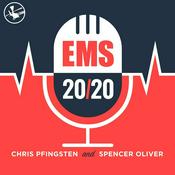74 episodes

PROPOFOL REPLACEMENT? CIPEPOFOL AND THE FUTURE OF HIGH-RISK CARDIAC INDUCTION │ EP74
1/09/2026 | 15 mins.
Welcome to the Atomic Anesthesia podcast hosted by CRNA professor Dr. Rhea Temmermand and Co-Founder Sachi Lord. On this show, you'll hear clear, clinically grounded discussions designed for nurse anesthesia residents and CRNAs who want to feel more confident in complex pharmacology, physiology, and real-world anesthesia decision-making.⚠️ SIGN UP FOR OUR FREE NEWSLETTER: [NEWSLETTER SIGN-UP]Topics included in this episode:Hemodynamic goals and risks during induction in severe aortic stenosisLimitations and hypotensive effects of propofol in aortic stenosis patientsPharmacology and potential advantages of cipepofol (ciprofol) as a propofol derivativeKey findings of the JAMA Surgery randomized trial comparing cipepofol vs propofol in severe ASPractical induction strategies and future implications for managing severe AS patients under anesthesiaARTICLE: Hemodynamic Impact of Cipepofol vs Propofol During Anesthesia Induction in Patients With Severe Aortic Stenosis💜 LIVE WEBINAR: Save your seat on our monthly, free webinars. Replays are sent to your inbox and you get access to all of our previous webinars.[WEBINAR SIGN UP]💜 FREE DOWNLOADS: Grab your copy of customized study plans & worksheets.[SEE/NCE STUDY PLAN][RN ICU DRUG CHART]💜 CONNECT: 📥 Email questions, comments or topic suggestions to Dr. Temmermand at [email protected], follow us on social media, and sign up for our newsletter.[NEWSLETTER SIGN-UP][INSTAGRAM] [TIKTOK] [YOUTUBE]

ANESTHESIA MACHINE CHECK: A STEP-BY-STEP WALKTHROUGH OF YOUR WORKSTATION │ EP73
1/05/2026 | 18 mins.
Welcome to the Atomic Anesthesia podcast hosted by CRNA professor Dr. Rhea Temmermand and Co-Founder Sachi Lord. On this show, you'll hear clear, clinically grounded discussions designed for nurse anesthesia residents and CRNAs who want to feel more confident in complex pharmacology, physiology, and real-world anesthesia decision-making.⚠️ SIGN UP FOR OUR FREE NEWSLETTER: [NEWSLETTER SIGN-UP]Topics included in this episode:Why a full anesthesia machine check mattersHow to perform a systematic pre-use machine checkoutUnderstanding and testing safety features and failure modesChecking ventilation, leak integrity, and waste gas handlingUsing structured tools to build a fast, reliable habit💜 LIVE WEBINAR: Save your seat on our monthly, free webinars. Replays are sent to your inbox and you get access to all of our previous webinars.[WEBINAR SIGN UP]💜 FREE DOWNLOADS: Grab your copy of customized study plans & worksheets.[SEE/NCE STUDY PLAN][RN ICU DRUG CHART]💜 CONNECT: 📥 Email questions, comments or topic suggestions to Dr. Temmermand at [email protected], follow us on social media, and sign up for our newsletter.[NEWSLETTER SIGN-UP][INSTAGRAM] [TIKTOK] [YOUTUBE]

NEW YEAR, NEW PROVIDER: ANESTHESIA RESOLUTIONS FOR 2026 │ EP72
1/02/2026 | 25 mins.
Welcome to the Atomic Anesthesia podcast hosted by CRNA professor Dr. Rhea Temmermand and Co-Founder Sachi Lord. On this show, you'll hear clear, clinically grounded discussions designed for nurse anesthesia residents and CRNAs who want to feel more confident in complex pharmacology, physiology, and real-world anesthesia decision-making.Topics included in this episode:Academic anchor habits for SRNAs and new CRNAsDeliberate clinical practice, including “one skill per shift” and quick weekly case debriefs.Mindset strategies like a “wins log” to fight imposter syndrome.Professional growth through scary-but-safe opportunities, CRNA business basics, and exploring fellowship prerequisites.Personal boundaries around sleep, non‑anesthesia hobbies, and phone/social media use to prevent burnout.Early burnout recognition and proactive check-ins with mentors or a therapist.💜 LIVE WEBINAR: Save your seat on our monthly, free webinars. Replays are sent to your inbox and you get access to all of our previous webinars.[WEBINAR SIGN UP]💜 FREE DOWNLOADS: Grab your copy of customized study plans & worksheets.[SEE/NCE STUDY PLAN][RN ICU DRUG CHART]💜 CONNECT: 📥 Email questions, comments or topic suggestions to Dr. Temmermand at [email protected], follow us on social media, and sign up for our launch newsletter ⬇️[NEWSLETTER SIGN-UP][INSTAGRAM] [TIKTOK] [YOUTUBE]

KETAMINE UNLOCKED: MECHANISMS, DOSING & CLINICAL PEARLS │ EP71
12/22/2025 | 23 mins.
Welcome to the Atomic Anesthesia podcast hosted by CRNA professor Dr. Rhea Temmermand and Co-Founder Sachi Lord. On this show, you'll hear clear, clinically grounded discussions designed for nurse anesthesia residents and CRNAs who want to feel more confident in complex pharmacology, physiology, and real-world anesthesia decision-making.Topics included in this episode:Ketamine’s dissociative mechanism and clinical applicationsDifferences between S- and R-ketamineHemodynamic and airway benefits in trauma and bronchospastic patientsMechanisms beyond NMDA antagonismDosing strategies for induction, sedation, and analgesic infusionsManaging emergence reactions, secretions, and ICP considerations💜 LIVE WEBINAR: Save your seat on our monthly, free webinars. Replays are sent to your inbox and you get access to all of our previous webinars.[WEBINAR SIGN UP]💜 FREE DOWNLOADS: Grab your copy of customized study plans & worksheets.[SEE/NCE STUDY PLAN][RN ICU DRUG CHART]💜 CONNECT: 📥 Email questions, comments or topic suggestions to Dr. Temmermand at [email protected], follow us on social media, and sign up for our launch newsletter ⬇️[NEWSLETTER SIGN-UP][INSTAGRAM] [TIKTOK] [YOUTUBE]

IF I WENT BACK TO CRNA SCHOOL, I'D STUDY LIKE THIS INSTEAD │ EP70
12/18/2025 | 27 mins.
Welcome to the Atomic Anesthesia podcast hosted by CRNA professor Dr. Rhea Temmermand and Co-Founder Sachi Lord. On this show, you'll hear clear, clinically grounded discussions designed for nurse anesthesia residents and CRNAs who want to feel more confident in complex pharmacology, physiology, and real-world anesthesia decision-making.Topics included in this episode:Perspective shifts with experience: how growth reshapes your learning and mindsetEffective study strategies: learning smarter with lasting retentionPhysiology over perfectionism: grounding complex topics in core principlesMemory maps for retention: turning scattered notes into visual frameworksBuilding networks early: connecting with mentors to boost confidenceDepth and curiosity: pursuing real understanding over grades💜 LIVE WEBINAR: Save your seat on our monthly, free webinars. Replays are sent to your inbox and you get access to all of our previous webinars.[WEBINAR SIGN UP]💜 FREE DOWNLOADS: Grab your copy of customized study plans & worksheets.[SEE/NCE STUDY PLAN][RN ICU DRUG CHART]💜 CONNECT: 📥 Email questions, comments or topic suggestions to Dr. Temmermand at [email protected], follow us on social media, and sign up for our launch newsletter ⬇️[NEWSLETTER SIGN-UP][INSTAGRAM] [TIKTOK] [YOUTUBE]
More Education podcasts
Trending Education podcasts
About Atomic Anesthesia
Listen to Atomic Anesthesia, IMO with Michelle Obama and Craig Robinson and many other podcasts from around the world with the radio.net app

Get the free radio.net app
- Stations and podcasts to bookmark
- Stream via Wi-Fi or Bluetooth
- Supports Carplay & Android Auto
- Many other app features
Get the free radio.net app
- Stations and podcasts to bookmark
- Stream via Wi-Fi or Bluetooth
- Supports Carplay & Android Auto
- Many other app features


Atomic Anesthesia
download the app,
start listening.







































